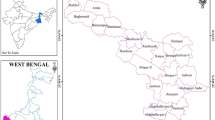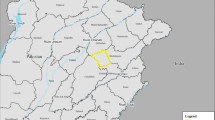Abstract
Geographic information system (GIS) has become one of the leading tools in the field of hydrogeological science that helps in assessing, monitoring, and conserving groundwater resources. Groundwater is a finite resource, which is being overexploited due to increase in demand over the years leading to decrease in its potentiality. In the present study, DRASTIC model has been used to prepare groundwater vulnerable zone in hard rock aquifer of granitic terrain. The main objective is to determine susceptible zone for groundwater pollution by integrating hydrogeological layers in GIS environment. The layers such as depth of aquifer, recharge, aquifer yield, soil type, topography, vadose zone, and transmissivity are incorporated in the DRASTIC model. The final output of the map shows that around 60% of the area falls under low to no risk of pollution zone. The high risk of pollution zones are mostly present towards the margin of southeastern periphery. The lower part of the basin as well as small area on northern side falls under moderate risk of pollution zone. For the assessment of groundwater pollution zone, 24 groundwater samples have been collected from different vulnerable zones. The chemical analysis of sample shows that the southeastern margin of basin has relatively high concentration of nitrate as compared to other parts of the basin. It is present in high pollution zone as well as moderate pollution zone. The present model can be used for assessment and management of groundwater.
Similar content being viewed by others

References
Aller, L., Bennett, T., Leher, J. H., Peetty, R. J., & Hackett G. (1987). DRASTIC: A standardized system for evaluating groundwater pollution potential using hydro-geological setting. EPA 600/2-87-035:622.
Baalousha, H. (2006). Vulnerability assessment for Gaza strip Palestine using DRASTIC. Environmental Geology, 50, 405–414.
Babikeri, I. S., et al. (2005). A GIS based DRASTIC model for assessing aquifer vulnerability in Kakamlgahara Heights, Glfu Prefecture, Central Japan. Science of the Total Environment, 345, 1–3.
Burchat, A., et al. (2006). Mapping the groundwater vulnerability in North Rhine–Westphaline, Germany. Environmental Engineering Science 23, 574–578.
Chitsanzan, M., et al. (2009). AGIS based DRASTIC model for assessing aquifer vulnerability in Kherran Plain, Khuzestan Iran. Water Resource Management, 23, 1137–1155.
El Naqa, A. (2004). Aquifer vulnerability assessment using DRASTIC index at Russeifa landfill northeast Jordan. Environmental Geology, 47, 51–62
Freeze, R. A., & Cherry, J. A. (1979). Groundwater book. Upper Saddle River: Prentice Hall.
Kim, Y. J., & Hamm, S. (1999). Assessment of potential for groundwater contamination using the DRASTIC/EGIS technique, Cheongjuarea, South Korea. Hydrogeology Journal, 7(2), 227–235.
Merchant, J. (1994). GIS-based groundwater pollution hazard assessment: A critical review of the DRASTIC model. Photogrammetric Engineering and Remote Sensing, 60(9), 1117–1127.
Rahman, A. (2007). A GIS based model for assessing groundwater vulnerability in shallow aquifer in Aligarh, India. Applied Geography, 28(1), 32–53.
Rao, Y. S., Reddy, T. V. K., & Nayudu, P. T. (1997). Groundwater quality in the Niva River basin, Chitoor district, Andhra Pradesh, India. Environmental Geology, 32(1), 56–63
Rupert, M. G. (2001). Calibration of the DRASTIC groundwater vulnerability mapping method. Ground Water, 39, 625–360.
Saro, L. (2003). Evaluation of waste disposal site using the DRASTIC system in the Southern Korea. Environmental Geology, 44, 654–664.
Singh, V. S., & Gupta, C. P. (1986). Hydrogeological parameter estimation from pumping test on large diameter well. Journal of Hydrology, 87, 223–232.
Singh, V. S., & Gupta, C. P. (1991). Interaction computer programme to interpret pumping test data from large diameter well. Water Resources Journal, 169, 33–41.
Verba, J., & Zaporozec, A. (1994). Guidebook on mapping groundwater vulnerability, Heinnz Heise, Hannover. International Contribution to Hydrology, 16, 131.
Xiaahu Wen., et al. (2008). A GIS based DRASTIC model for assessing shallow groundwater vulnerability in the Zhangy Basin, north western China. Environmental Geology, 57, 1435–1442.
Author information
Authors and Affiliations
Corresponding author
Rights and permissions
About this article
Cite this article
Prasad, R.K., Singh, V.S., Krishnamacharyulu, S.K.G. et al. Application of drastic model and GIS: for assessing vulnerability in hard rock granitic aquifer. Environ Monit Assess 176, 143–155 (2011). https://doi.org/10.1007/s10661-010-1572-7
Received:
Accepted:
Published:
Issue Date:
DOI: https://doi.org/10.1007/s10661-010-1572-7



